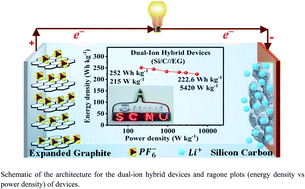A new dual-ion hybrid energy storage system with energy density comparable to that of ternary lithium ion batteries†
Abstract
Supercapacitors that store energy through dual electrochemical layer capacitance or surface faradaic redox reactions are characterized by their fast charging/discharging capability, high power densities, and long cycling lifetime. However, the low energy density of supercapacitors seriously inhibits their practical applications. Herein, a dual-ion hybrid energy storage system using expanded graphite (EG) as the anion-intercalation supercapacitor-type cathode and graphite@nano-silicon@carbon (Si/C) as the cation intercalation battery-type anode is designed for efficient energy storage. The Si/C anode, synthesized by interfacial adhesion between nanosilicon and graphite with the help of pitch, demonstrates high specific capacity, remarkable cycling stability, and enhanced rate capability. Meanwhile, the EG cathode, which stores energy based on electrochemical double layer capacitance through its unique faradaic pseudocapacitive negative anion intercalation behaviour, demonstrates high energy densities of 462.9–356.5 W h kg−1 at power densities of 403–7130 W kg−1. The resulting Si/C//EG hybrid system delivered highly attractive energy densities of 252–222.6 W h kg−1 at power densities of 215–5420 W kg−1, which are superior to those of conventional electrochemical double layer capacitors and lithium-ion capacitors, making the dual-ion hybrid system a new type of energy storage device capable of achieving fast and efficient energy storage.

- This article is part of the themed collection: 2020 Journal of Materials Chemistry A most popular articles


 Please wait while we load your content...
Please wait while we load your content...